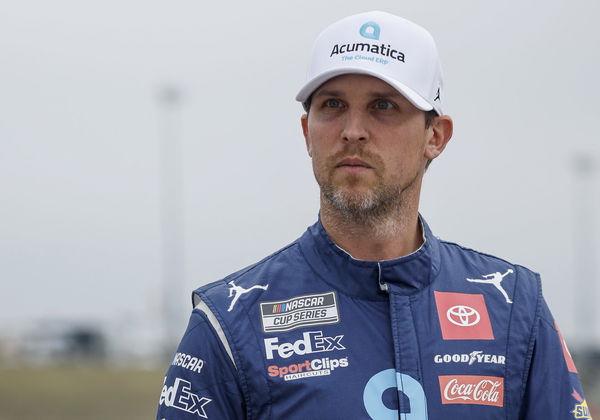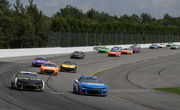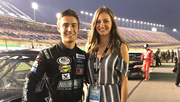
via Getty
KANSAS CITY, KANSAS – SEPTEMBER 10: Denny Hamlin, driver of the #11 Acumatica Toyota, walks the grid during practice for the NASCAR Cup Series Hollywood Casino 400 at Kansas Speedway on September 10, 2022 in Kansas City, Kansas. (Photo by Chris Graythen/Getty Images)

via Getty
KANSAS CITY, KANSAS – SEPTEMBER 10: Denny Hamlin, driver of the #11 Acumatica Toyota, walks the grid during practice for the NASCAR Cup Series Hollywood Casino 400 at Kansas Speedway on September 10, 2022 in Kansas City, Kansas. (Photo by Chris Graythen/Getty Images)
After three years of a lackluster Road Course experiment, the Indianapolis Motor Speedway will make its annual return with the 27th edition of the Brickyard 400. To gather progressive information for the intended tires awaiting July 21st, and the Next-Gen car’s drafting performance on its debut at Indy’s 2.5-mile oval circuit, Goodyear and NASCAR conducted a test run only this past week.
Denny Hamlin (Toyota), Kyle Busch (Chevrolet) & Todd Gilliland (Ford) were each chosen to represent their respective race team’s current OEMs at Brickyard. The official timings and findings are yet to be revealed/implemented.
However, Hamlin may have already stumbled on a potential fix well in advance, and it’s quite a contrary narrative to his usual stance demanding NASCAR to increase its horsepower. If anything the Chesterfield-native wishes NASCAR’s governing body could take some notes from the IndyCars playbook.
ADVERTISEMENT
Article continues below this ad
Denny Hamlin’s puzzling solutions with lower speeds at the Brickyard
Before the Brickyard peeked its head at the NASCAR season, Kyle Larson kicked off its stock car acclaim just last month, with an infamous Mother Nature vs Indy-Charlotte “Double” duel. Although the Hendrick #5 driver finished P17 at IMS and fell into a week-long waiver controversy with NASCAR, the racing in itself at Indiana on Memorial Day weekend was arguably another white-knuckled affair. After all, Larson’s Arrow-McLaren teammate and the runners-up of the 2024 Indy 500, Pato O’Ward finished only 0.3417 seconds behind eventual winner, Josef Newgarden, battling tooth-and-neck till the very finish.
Denny Hamlin’s second-place finish at Gateway last week stands in what one would say, stark contrast. In the background of a now-lost Joe Gibbs Racing 1-2 sweep, the #11 Toyota only visited the podium after his teammate Christopher Bell faced issues in the final stages. But before these fortunes, Denny was advocating for two things primarily. One – an increase in the engine displacement output of the newer Gen 7 vehicles. And two, a guaranteed waiver for Kyle Larson due to his rained-out no-show in Charlotte. This week heading to Sonoma, Bob Pockrass had a few questions to pose to Denny Hamlin concerning his tire test at the Brickyard, especially regarding his views on Indy’s revised excitement.
Explaining his derived perspective, after running laps for testing on the iconic oval circuit making its return to the season’s calendar for the first time since 2020, Hamlin projected, “I thought Indy was about what you would expect. I certainly think that qualifying will be a big deal.” Noting the incapabilities presented by the NextGen car on tracks two miles and above, he then speculated about an unconventional remedy specific to the Brickyard: “I think that, in my opinion, if we could, it’s too late to do this now, but if we could slow those cars down about 10 miles an hour in the corner. And I know that we’re already running really slow, but you want to see an Indy-type race, right? Where there’s drafting, slingshot passes at the end of the straightaway.”
Denny Hamlin said they brought a softer tire to Indy and feels they are creeping up on finding a tire that has more fall-off. What he said about Indy test and bringing the “primary” tire from North Wilkesboro to Iowa and New Hampshire. pic.twitter.com/FyODFTVPwM
— Bob Pockrass (@bobpockrass) June 8, 2024
But why does Denny Hamlin think this way? He continued to elaborate, “My fear is that… the second-place car or the third-place car, whatever it’s going to be in such a big wake that they’re not going to be able to make up that distance on the straightaway. So I certainly believe (it) will be a track position type race, just because the corner speeds were just on the edge of having not enough grip there.”
Pockrass aimed to gather all the information, asking Denny if the action at Indy next month would be “more like a short track” instead of the exciting intermediate outings this year. Hamlin answered, “No, it’s not going to be a Kansas or anything like that. I mean we’ve said it a million times. The wider the track, the better the racing. And that is the narrowest of narrow tracks.” To compare, IMS’s oval circuit boasts an average width of 17 meters throughout its 2.5-mile length. Both the short & long straightaways are at 16 meters each while the four 9.2-degree banked turns are around 18 meters wide. The Next-Gen car has roughly a width of around 79 inches or 6 and a half feet.
ADVERTISEMENT
Article continues below this ad
On paper, that does suggest an abundance of passing opportunities mathematically. But with at least 36 cars running at speeds nearing 200 miles per hour, the narrowest of inches could play out a huge difference. Kyle Busch stressed that point gravely when he crashed out during his test run at Indy.
Trending
Is the Next-Gen car for ovals?
Following the conclusion of Goodyear’s tire assessment on Wednesday, the 2-time Brickyard winner stole major headlines after posts on social media portrayed a sorry picture at Indy for RCR’s #8 Chevy. According to Goodyear and other major sources, Busch crashed out on Turn 2 and the incident “was not the result of a tire failure of any kind.” Thankfully, he was able to exit the car under his power and sustained no significant damages days ahead of his Sonoma advance.
ADVERTISEMENT
Article continues below this ad
It is safe to say that KFB is not having the season we have come to expect from a former two-time Cup Series champion. Regardless, Denny believes Goodyear is heading in the correct trajectory with its gradual tweaks to optimize the excitement to the highest level, disregarding the criticisms surrounding the Next-Gen car. With the conversations evolving, he further revealed to Pockrass, “It seems like they’re creeping up on it. They’re going with a softer tire for Indy on the right side, (and) a heavier gauge tire on the left. So, we’re creeping into it.”
In an unrelated interview with the official IMS social media channel, Denny Hamlin also discussed how the Next-Gen car “is actually made better for the oval.” Nevertheless, he ultimately admits, yet again, that the race in itself will fare better for those with favorable “track position.” Additionally, the Brickyard 400 on July 21st will also be the last race before the NASCAR season goes on hold for a two-week break for the Olympics. Will the governing body and its stakeholders use this downtime to craft an even better solution than the one Hamlin provided?
ADVERTISEMENT
ADVERTISEMENT
ADVERTISEMENT
ADVERTISEMENT





